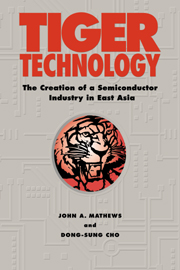Book contents
- Frontmatter
- Contents
- List of Figures
- List of Tables
- Preface
- Abbreviations
- Introduction
- Part I The ‘Real’ East Asian Miracle
- Part II National Institutional Pathways
- 3 The Tangun Boom and the Chaebol: How Korea Did it
- 4 A Cat Can Look at a King: How Taiwan Did it
- 5 Jack and the Beanstalk: How Singapore and Malaysia are Doing it
- Part III The Technology Leverage Strategy
- Appendix I Exchange Rates: 1975–97
- Appendix II Chronolog
- Glossary
- Bibliography
- Index
3 - The Tangun Boom and the Chaebol: How Korea Did it
Published online by Cambridge University Press: 09 October 2009
- Frontmatter
- Contents
- List of Figures
- List of Tables
- Preface
- Abbreviations
- Introduction
- Part I The ‘Real’ East Asian Miracle
- Part II National Institutional Pathways
- 3 The Tangun Boom and the Chaebol: How Korea Did it
- 4 A Cat Can Look at a King: How Taiwan Did it
- 5 Jack and the Beanstalk: How Singapore and Malaysia are Doing it
- Part III The Technology Leverage Strategy
- Appendix I Exchange Rates: 1975–97
- Appendix II Chronolog
- Glossary
- Bibliography
- Index
Summary
In February 1983, Korea's most famous businessman, Lee Byung-Chull, founder and chairman of Samsung, made his most famous statement in a long and distinguished career. Samsung intended, he said, to become a world player in memory chip production. He was prepared to put up 100 billion won – an astonishing $133 million – to back his assertion for a company as small as Samsung. In effect he was betting the future of the company on semiconductors. Less than two years later, Samsung astonished the world with its 64K DRAM, produced at its gleaming new wafer-fabrication plant at Kiheung. Within another two years, it was making profits from its 256K DRAM, produced only months after Japanese industry leaders were scaling up their own production. Within less than ten years, Samsung had emerged as the world's number one producer of DRAMs, generating enormous wealth for itself and Korea in the process.
Lee was no stranger to challenges, having navigated Samsung from one industry to another, always noting where Japan had been successful and seeking to emulate the Japanese strategy, but with lower costs. He grew up under the Japanese occupation of Korea, studied for a time at Waseda University in Japan, and in 1936 founded a small rice mill in Taegu, southern Korea, with inherited funds. Over the next few years Lee traded in commodities, expanding into Japanese-occupied Manchuria. In 1938 he incorporated his small venture as Samsung Commercial Company (Samsung means ‘three stars’ in Korean), modelled on the triple diamond of Japan's Mitsubishi.
- Type
- Chapter
- Information
- Tiger TechnologyThe Creation of a Semiconductor Industry in East Asia, pp. 105 - 156Publisher: Cambridge University PressPrint publication year: 2000



